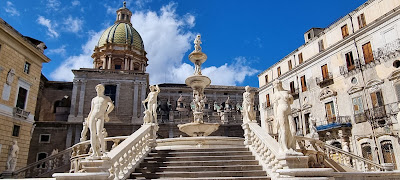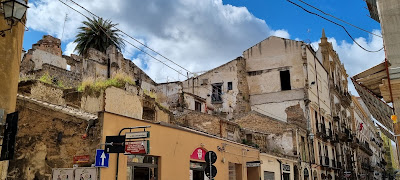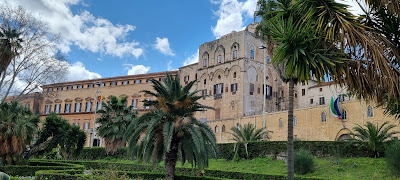11 March 2024 – Palermo
Miles driven today = 0
Total Miles to date = 2,248
It’s been 3 weeks since we went marching around Florence so I was ready for another City excursion and really quite excited at the prospect. We made a rough list of the sites that we particularly wanted to see and jumped on the 107 bus which took us all the way through to the Central Station.
We quickly found our way to the Bullaro Market which winds its way through a succession of narrow streets. On the fruit and veg stalls fennel, aubergines and artichokes were in abundance and very seasonal at the moment.Plenty of citrus fruit too. Some of the lemons were gigantic. Several times the size of what you would find on the supermarket shelves at home.These are Sicilian Cannoli. A traditional pastry containing ricotta. We bought some later in the day and they are fiendishly good. We found that they are also completely impossible to eat without covering yourself in icing sugar.Street food lovers are absolutely in seventh heaven in Palermo and a lot of the traders were gearing themselves up for lunchtime.This photo is in many ways representative of Palermo as a whole. The once splendid dome of the Church of Carmine Maggiore surrounded by dilapidation and graffiti.Over the course of history Sicily has been under the control of the Greeks, Phoenicians, Carthaginians, Romans, Arabs, Normans, French, Spanish and the Bourbons before being united with the rest of Italy under Garibaldi in 1860. The culture and the architecture are therefore a complete melting pot. On the left here we have the 12th Century Church of Santa Maria dell’Ammiraglio (also known as “La Martorana”) which includes Islamic architectural features, whereas on the right is the Arabian-Norman Catholic Church of San Cataldo constructed in 1154.We paid a couple of euros each to go into the former of these. The Byzantine style mosaics were breathtaking.This is looking up into the dome.The marble reliefs behind the main altar are also quite amazing.The 16th Century Praetorian Fountain was originally built as a garden ornament for a Florentine nobleman. But he sold it to Palermo when he fell upon hard times.The Piazza it is situated in subsequently became known in the 18th Century as the “Square of Shame” due to the nudity of the statues.In the background you can see the dome of the Baroque Catholic Church of St Joseph of the Theatine Feathers.
Once again the interior decoration here is quite extraordinary.More intricate marble sculpture.We also had a quick nose around down in the crypt. This is the altar down there.The Quattro Canti (“Four Corners”) with its four curved Baroque facades, was built at the beginning of the 17th Century and forms the intersection where the four main central districts of Palermo meet.This is the Piazza Bologni with its statue of Carlo V, which seemed a nice spot to enjoy a coffee while being serenaded by a gentleman playing a lute.Palermo was heavily bombed by Allied forces during WWII and supposedly as many as 70 Churches were totally destroyed (although there still seems to be one on every street corner). Despite major reconstruction programmes there are still areas, even in the City centre, that are completely derelict. The Cathedral dates from the 12th Century at a time when Palermo’s positioning on the Mediterranean trade routes made it the most prosperous City in Europe. Externally it is very grandiose with extensive Norman features.Inside it’s a much plainer affair in comparison to some of the other churches nearby.The Porta Nuova dates from the early 16th Century and marked the Western extent of the City at that time. It was built to commemorate Charles V’s Tunisian Crusades. The Norman Palace was actually built by the Saracens but then extended in Norman times. It now houses the Sicilian Regional Parliament as well as exhibitions.The lush gardens of Villa Bonanno.It was lunchtime so we made our way through the Vucciria Market to the Piazza San Domenico where we plonked ourselves down at a restaurant called Lucchese.I ordered stuffed squid with a pea sauce while Lisa had grilled swordfish and we also shared a plate of grilled vegetables. All very enjoyable despite a sharp shower which forced us inside halfway through our meal.Afterwards we ambled on through some of the narrow streets and alleys of the Vucciria and Capo Quarters.The Massimo Theatre was the largest Opera House in Italy and only third in Europe behind those in Paris and Vienna when it first opened its doors to the public in 1897.It was also the location used for the finale of the Godfather film trilogy.More market browsing, this time in the Capo market. These are all different varieties of salt from Trapani, where we should be in 2 to 3 days’ time.If we hadn’t already eaten I would have been very tempted.We picked up a few of these herb mixes which you combine with olive oil to dress your pasta. Only €1 a sachet.So many varieties of big juicy olives to choose from too.Around the markets we saw a number of unmarked drinking dens where you could pick up a cheap bottle of Peroni. We had to chuckle at this one though celebrating Birmingham’s version of the mafia.Although there is a huge amount of graffiti around Palermo we found a lot of it to be well drawn, imaginative and often amusing.So what were our impressions on Palermo? Well I think it’s fair to say we both really liked it. Away from the tourist centre it is absolutely filthy with rubbish strewn along the pavements. But if you can look beyond that and you are into your architecture, religious art, some fabulous culture and brilliant, reasonably priced street food then I can certainly recommend it for a weekend break. It also felt totally safe although one always takes all the usual precautions of keeping wallets and phones zipped away from potentially light fingers.
12 March 2024 - Monreale & Scopello


































Comments
Post a Comment